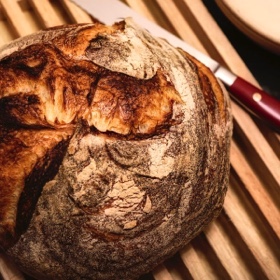Ingredients
350 grams (1 ½ cups) warm water at 80-85°F
120 grams (2/3 cup) sourdough starter or mother yeast
500 grams (4 cups) bread flour, plus more for dusting and coating
7 grams (1 ¼ tsp) salt – for pane pugliese, optional
Directions
In a large bowl, combine the warm water and the starter. Using your hands, break down the starter until it completely dissolves into the water.
Add the flour and mix with your hands until a dough forms and there are no lumps. The dough should feel elastic and slightly wet. (If making pane pugliese, add the salt now and mix well.) Transfer the dough to a plastic container and cover with a cloth. (If you’re working with a mother yeast, which is a saved piece of the previous day’s bread dough, remove approximately 120 grams before adding salt and set it aside in a partially ventilated plastic container. This will be the starter for the following day.)
Every 30 minutes for 2 hours, wet your hands and gently pull the dough away from the sides of the container toward yourself, then fold it back inside the container. Let the dough sit for 3 hours, after which the first rise will be complete, and the dough should have grown by one-third to one-half its original volume.
Transfer the dough to a non-porous work surface like a marble counter or table. Using a bench knife (also known as a dough scraper), mold the dough into a round shape and let it rest for 30 minutes. The dough will relax and look like a deflated ball at this point.
Coat a round, lined proofing basket—a banetton—with bread flour, or, if using a new banetton, a mixture of 70 percent bread flour and 30 percent rice flour. (Rice flour is very dry, and will help prevent the dough from sticking to the sides.)
With the bench knife, flip the dough. Then stretch it to about 3 times its original length. Fold it back to its original size, roll it lightly in your hands, and place it in the banetton. Cover with a kitchen towel and let it rise undisturbed in a warm spot for 3 hours. (An oven with its interior light turned on works quite well, protecting the dough from sudden temperature changes.)
Place a pizza stone and a 5-quart cast-iron Dutch oven in the oven. Preheat the oven to 500°F and let the pot sit in the oven for 30 minutes.
Place a sheet of parchment paper over the banetton and place a pizza stone on top, and gently turn upside down. Carefully remove the banetton to uncover the bread, which should now be resting on the parchment paper–lined pizza stone. Be careful not to rip any potentially sticking dough, especially if using a new banetton. (Ripped dough won’t rise properly in the oven.)
Using a very sharp knife, make 2 or 3 short cuts in the dough along the white lines left on the dough on the sides of the banetton.
Gently slide the parchment paper with the dough onto the pizza stone and cover with the overturned cast iron pot. Reduce the temperature to 450°F. (All ovens are different – so after a trial run, you may determine the heat needs to be higher.)
Bake for 30 minutes. Remove the cast iron pot. The loaf should be golden in color, with a smattering of dark edges. Bake an additional 10-15 minutes uncovered, moving the bread occasionally to ensure the loaf bakes evenly on all sides until the crust looks lightly toasted in color, with a slightly blistered appearance.
Remove the bread from the oven and cool on a wire rack, uncovered, for at least 1 hour.
